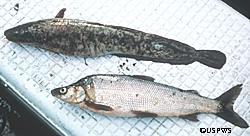Alaska Fish & Wildlife News
February 2007
Poor Mans Lobster Newburg - Made with Burbot

Start by preparing:
Dave Parker’s Upper Tanana “Lobster”
2 cups burbot
4 tbsp. Butter
¾ cup white wine
1. Cut meat into bite size chunks
2. Melt butter over medium low heat, then slowly add the wine
3. Add chunked burbot and simmer until opague- all fish is white and just cooked through
4. Remove from heat, drain off and discard liquid, and set aside
Newberg Sauce
4 tbsp. butter
1 ½ tbsp. flout
2 cups cooked burbot (from above)
¼ cup sherry, cognac or white wine
½ tsp salt
1 pinch of paprika (this is mostly for color )or for more zing, cayenne pepper
2 egg yolks beaten slightly
1 ½ cups cream (or subsititute 1 1/3 cup milk heated with 2 tbsp butter)
2 tbsp chervil or parsley
Using a double boiler (or a stainless steel bowl that fits snugly on top of a saucepan -beware of steam escaping) melt butter over low heat. Whisk in flour and continue stirring until flour and butter meld- approx 3 minutes stirring constantly. Add sherry (or substitute) whisking until a sauce begins to form. Add salt and paprika continuously whisking sauce.
Beat eggs in a separate bowl. Add cream to eggs and whisk. Whisk in egg/cream mixture to the sauce and whisk until sauce thickens. Use a spatula to bring any of the flour mixture from the bottom of the double boiler into the cream and continue whisking.
Fold burbot into sauce with a spatula or spoon, avoid over mixing or the fish will flake apart. Heat until burbot is heated through.
Serve over toast points for an appetizer or over poached eggs and English muffins for a delicious breakfast. Garnish with sprinkled chervil or parsley, salt and pepper.
A little history on the origins of the dish…
Delmonico’s restaurant in NYC first offered this dish as Lobster á la Wenberg on their menu in 1876. The owner/manager was offered the dish by wealthy sea captain, Ben Wenberg. Delmonico’s chef made some refinements to the dish and quickly it became popular.
The dish was pulled from the menu after an argument - leading to a bit of a brawl - between the restaurateur and the sea captain ensued in the fancy restaurant. Patron’s loved the dish and continued to request it. To satisfy their tastes, Charles Delmonico got his revenge on the sea captain by changing the name of the dish to Lobster á la Newberg or Lobster Newberg.
Subscribe to be notified about new issues
Receive a monthly notice about new issues and articles.
